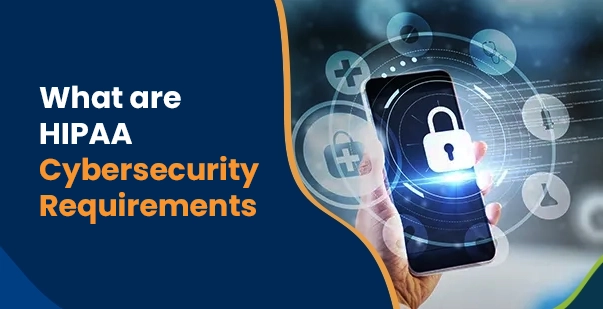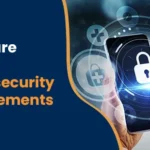What are HIPAA Cybersecurity Requirements?

July 14, 2025
Concerns around the Health Insurance Portability and Accountability Act (HIPAA) have intensified in the healthcare space over the past couple of years. Every healthcare organization requires technology to function daily. But when you use technology to collect, transmit, or handle your patient’s ePHI (electronically protected health information), you will be exposed to all kinds of cybersecurity risks.
If those risks are not managed promptly, they might lead to expensive data breaches that disrupt your operations and harm your patients’ privacy. The US Department of Health and Human Services reported a loss of $6.2 billion in the US healthcare system due to data breaches.
So, how can healthcare providers proactively address these challenges using HIPAA cybersecurity requirements? Let’s explore how HIPAA Cybersecurity protects valuable healthcare information from potential digital threats.
Decoding HIPAA
HIPAA is a federal law that protects the sensitive health information of patients from being disclosed without their consent or knowledge. The law enacted in 1996 comprises the following relevant rules for cybersecurity compliance:
- Privacy Rule – Governs the use and disclosure of protected health information (PHI)
- Security Rule – Sets standards for protecting electronic PHI
- Breach Notification Rule – Requires notifying individuals and authorities in the event of a data breach.
HIPAA compliance also includes penalties for violations and mandatory business associate agreements. It is important for protecting patient privacy, maintaining data security and availing legal repercussions or penalties for noncompliance.
Read More: What is the HIPAA Privacy Rule?
Risks in Cybersecurity
HIPAA governs every type of patient health information, including their health history, test results, treatment details and other identifiable data. As a part of a healthcare organization, you should not disclose this information unless the patients consent to share such information for any agreed purpose.
Maintaining and storing patient health resources, especially ePHI, involves several risks. Developing cybersecurity policies will help mitigate potential data breaches and other attacks. Here are some cybersecurity risks for your organization.
-
Malware
Malware is the most common cybersecurity threat. It involves installing unauthorized software or programs to attack a target system with the intent of causing damage. It might delete important files, steal information, or damage the entire systems within your network.
-
Phishing
Phishing uses social engineering to trick users into revealing credentials or clicking malicious links—often by posing as trusted contacts. During this type of attack, The attacker impersonates a trusted authority to deceive users into compromising sensitive information.
-
DDoS
DDoS is a type of cybersecurity threat in which the malicious party directs an overload of traffic to the target system. The primary goal of the attack is to overwhelm the user’s system until it is unable to handle the surge of traffic, forcing it to shut down the website.
-
Password Theft
Password theft happens when an illegal party gains access to your email or other important login credentials. The attacker will change your password, which will deny you access to the account or the system itself.
-
Traffic Interception
Traffic interception is another type of cybersecurity threat, commonly referred to as ‘digital eavesdropping.’ It happens when a third-party, unauthorized user intercepts the exchange of communication between two users to collect sensitive information about the patients.
HIPAA Cyber Security Requirements for Compliance
HIPAA enforces various requirements related to IT and computing, among which are detailed cybersecurity requirements by the US Department of Health and Human Services (HHS), a part of OCR (Office of Civil Rights). They are in charge of imposing fines and penalties for non-compliance, as well as taking legal action against those who violate HIPAA cybersecurity regulations. Some of the HIPAA cybersecurity requirements include,
1. Risk Analysis and Management
HIPAA requires most organizations, individuals, and covered entities to conduct risk analyses. The risk analysis will identify and assess potential vulnerabilities to ePHI (electronic protected health information), ensuring integrity and confidentiality. This will help you implement the necessary techniques, including physical and administrative precautions, to secure patient data.
The risk analysis and management includes the following steps:
- Identifying and documenting the systems and applications that consist of or transmit ePHI.
- Identifying and assessing the potential risks, including unauthorized access, disclosure, or destruction.
- Assessing the likelihood of risks and their associated impact.
- Implementing adequate protections to address the vulnerabilities, including encryption, firewalls, and access controls.
- Regularly reviewing and updating the risk analysis and management plan.
Read More: What is Risk Management in Healthcare?
2. Safeguarding Third-Party Applications
Third-party application security demands high-precautionary measures to protect sensitive medical information when it is stored, processed, or transmitted by any third-party software or software-as-a-service (SaaS) solutions.
To secure such solutions that access IP or data, you can follow the measures below:
- Evaluate the security practices of the user, including the data encryption methods, access controls, and security certifications.
- Require the vendor to agree to the Business Associate Agreement (BAA), which defines their responsibility to protect the data and comply with HIPAA regulations.
- Regularly monitoring the user’s compliance with HIPAA regulations.
- Implementing security measures, including data backup and disaster recovery plans, to prevent the risk of data loss or breaches.
3. Administrative Protections
Administrative protections are defined as a set of policies and procedures that require covered entities and business partners to implement measures to protect their ePHI. These include the proper management and use of ePHI and the implementation of security management procedures to prevent unauthorized access, disclosure, use, or destruction of ePHI.
Here are some primary instances of administrative safeguards:
- Implementing and maintaining written policies and procedures for HIPAA regulations.
- Hiring a security official to be responsible for HIPAA compliance.
- Providing regular security awareness training to all employees.
- Regularly reviewing incident response and data breach notification procedures.
- Conducting regular risk analysis and management activities.
- Performing regular monitoring and testing of security controls to ensure optimal function.
- Enforcing proper access controls to ePHI.
4. Physical Safeguards
Physical protections are known as security measures that organizations and associates should implement on their premises to protect all ePHI from physical threats, including unauthorized access, natural disasters, or theft.
Here are some examples of physical safeguards:
- Controlling access to facilities that secure ePHI using locked doors, security guards, or CCTV cameras.
- Securing the workstations and devices that store or transmit ePHI by using cable or other physical devices.
- Maintaining and monitoring an inventory of all the hardware and equipment that stores or transits ePHi, including mobile devices, desktop computers, servers, and laptops.
- Establishing and maintaining an emergency response plan to protect ePHi during natural disasters or other emergency occurrences.
- Regular inspection of physical security measures to ensure its ideal functioning as intended.
- Maintaining an incident response plan and procedures to properly handle the lost documents or stolen devices that contain ePHI.
5. Access Control
Access control is another component of the HIPAA cybersecurity framework. It involves granting or denying access to ePHI based on one’s role within the organization. These control measures ensure that only authorized people will have access to your organization’s ePHI as needed to perform their jobs.
Some of the access control measures include
- Authentication: Verifying the identity of an individual who needs access to ePHI. It includes usernames and passwords, tokens, or biometric identification.
- Authorization: Determining whether an individual is authorized to access or manipulate ePHI based on their role. It includes granting access to particular information, applications, or systems required to perform the job.
- Auditing: Tracking and logging every user’s access to ePHI, including the date, time, name of the users, the type of information accessed, and the actions taken.
- Access Control Lists: Defining and maintaining the proper list of users who have authorization to access ePHI, including the level of access granted to each individual.
6. Policies and Processes
HIPAA requires healthcare organizations and their associates to implement a set of written policies and procedures to ensure the integrity of ePHI. These procedures should be designed to meet the specific needs and operations of the covered entity. Moreover, they also should be revered and updated regularly.
Here are some policies that you should consider while crafting the cybersecurity plan for your organization:
- Security Management Process: A process that defines how your organization will identify and manage risks to the privacy of ePHI.
- Incident Response: It includes the procedures for responding, reporting, and implementing security incidents involving ePHI.
- Remote Access: Procedures for accessing ePHI security from remote locations by using VPNs (virtual private networks) or other secured access methods.
- Business Associate Agreements: This includes the agreement with business associates to ensure that they will comply with HIPAA relations.
- Sanction Policy: A written procedure for disciplining workers who fail to comply with HIPAA cybersecurity requirements.
Best Practices for Maintaining HIPAA Cyber Security Requirements
In the world of networks and computers, protect sensitive patient data against hackers, spammers, identity thieves, and more. To tackle this growing threat, here are some best practices to maintain your HIPAA cybersecurity requirements.
- Have a Backup Plan: Healthcare organizations should prioritize delivering critical care to patients. During a cyberattack or power outage, you should be prepared to restore your patient data quickly and offer proper services.
- Strengthen Your Network Security: Ensure that your firewall intrusions and VPNs are up-to-date and configured properly for maximum protection against unauthorized access and cyberattacks.
- Continuous Monitoring: Compliance requirements and IT infrastructure are constantly evolving. Therefore, make sure to continuously monitor your efforts and regulatory conduct testing to identify any security weaknesses.
- Tailor the Policy: The security policy should be tailored to meet the specific needs of your organization. You should take her organization’s size, complicity, and technical infrastructure into account.
- Communicate the Policy: Communicate your security policy to the entire workforce, including business associates or any other parties.
- Employee Training: Educate your employees about the requirements for HIPAA cybersecurity and its strategies to ensure the security and integrity of your organization.
Protect Your Patient’s Data with HIPAA Cybersecurity!
Cybersecurity threats will continue to evolve. Therefore, organizations must stay vigilant and implement best practices to protect sensitive data. Ensuring compliance with HIPAA Cybersecurity regulations safeguards patient data and maintains trust.
Once you understand the components of HIPAA training and adhere to its requirements, you can mitigate risk and promote your overall security posture. Prioritizing the HIPAA requirements will help your organization meet regulatory standards and show your commitment to upholding patient privacy in an increasingly digital sphere.





